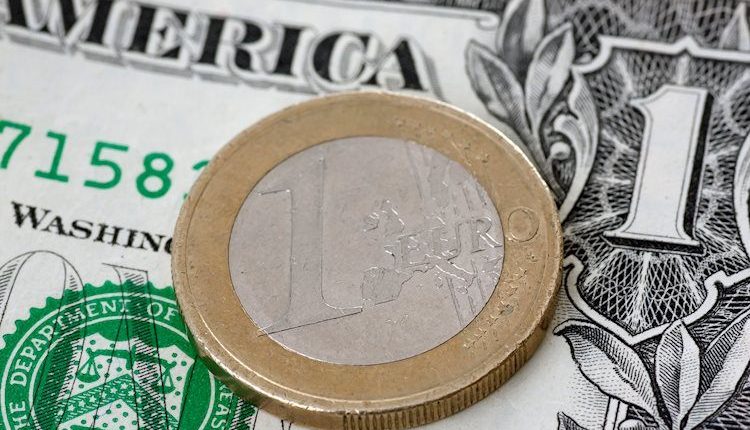- EUR/USD appreciates despite a negative bias amid the cautious US Federal Reserve.
- Fed Chair Powell stated that the economy is not sending any signals that we need to lower rates quickly.
- The headline inflation in the Euro Area is projected to drop sharply to 2.4% in 2024, from 5.4% in 2023.
The EUR/USD pair trades around 1.0550 during Monday’s Asian trading session, hovering near its yearly low of 1.0496, which was reached on November 14. Downside risks for the pair have intensified following cautious comments from Federal Reserve (Fed) officials and stronger-than-expected US Retail Sales data, broadly supporting the US Dollar (USD).
Last week, Fed Chair Jerome Powell tempered expectations for imminent rate cuts, emphasizing the economy’s resilience, a strong labor market, and persistent inflationary pressures. Powell stated, “The economy is not sending any signals that we need to be in a hurry to lower rates.”
The CME FedWatch Tool indicates that markets are pricing in nearly a 60% probability of a 25-basis-point rate cut by the Fed at its December meeting.
The US Census Bureau reported on Friday that Retail Sales increased by 0.4% month-over-month in October, exceeding the market consensus of 0.3%. Additionally, the NY Empire State Manufacturing Index for November posted an unexpected surge, coming in at 31.2 compared to the anticipated 0.7 decline, signaling robust manufacturing activity.
The Euro faces continued downward pressure as the European Central Bank (ECB) maintains a dovish stance, with a policy rate cut expected at its upcoming December meeting. Headline inflation in the Euro Area is projected to drop sharply to 2.4% in 2024, down from 5.4% in 2023, before easing more gradually to 2.1% in 2025 and 1.9% in 2026.
The European Commission’s Autumn 2024 forecast projects 0.8% growth for the Euro Area in 2024, unchanged from the Spring forecast. However, the 2025 growth forecast has been revised slightly downward to 1.3% from 1.4%, while the Eurozone economy is projected to grow by 1.6% in 2026.
EU Economy Commissioner Paolo Gentiloni stated, “As inflation continues to ease and growth in private consumption and investment gains momentum, alongside record-low unemployment, growth is expected to gradually accelerate over the next two years.”
Euro FAQs
The Euro is the currency for the 19 European Union countries that belong to the Eurozone. It is the second most heavily traded currency in the world behind the US Dollar. In 2022, it accounted for 31% of all foreign exchange transactions, with an average daily turnover of over $2.2 trillion a day. EUR/USD is the most heavily traded currency pair in the world, accounting for an estimated 30% off all transactions, followed by EUR/JPY (4%), EUR/GBP (3%) and EUR/AUD (2%).
The European Central Bank (ECB) in Frankfurt, Germany, is the reserve bank for the Eurozone. The ECB sets interest rates and manages monetary policy. The ECB’s primary mandate is to maintain price stability, which means either controlling inflation or stimulating growth. Its primary tool is the raising or lowering of interest rates. Relatively high interest rates – or the expectation of higher rates – will usually benefit the Euro and vice versa. The ECB Governing Council makes monetary policy decisions at meetings held eight times a year. Decisions are made by heads of the Eurozone national banks and six permanent members, including the President of the ECB, Christine Lagarde.
Eurozone inflation data, measured by the Harmonized Index of Consumer Prices (HICP), is an important econometric for the Euro. If inflation rises more than expected, especially if above the ECB’s 2% target, it obliges the ECB to raise interest rates to bring it back under control. Relatively high interest rates compared to its counterparts will usually benefit the Euro, as it makes the region more attractive as a place for global investors to park their money.
Data releases gauge the health of the economy and can impact on the Euro. Indicators such as GDP, Manufacturing and Services PMIs, employment, and consumer sentiment surveys can all influence the direction of the single currency. A strong economy is good for the Euro. Not only does it attract more foreign investment but it may encourage the ECB to put up interest rates, which will directly strengthen the Euro. Otherwise, if economic data is weak, the Euro is likely to fall. Economic data for the four largest economies in the euro area (Germany, France, Italy and Spain) are especially significant, as they account for 75% of the Eurozone’s economy.
Another significant data release for the Euro is the Trade Balance. This indicator measures the difference between what a country earns from its exports and what it spends on imports over a given period. If a country produces highly sought after exports then its currency will gain in value purely from the extra demand created from foreign buyers seeking to purchase these goods. Therefore, a positive net Trade Balance strengthens a currency and vice versa for a negative balance.
Read the full article here

